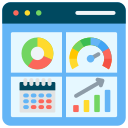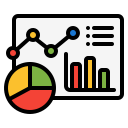3.0. Core application of data analytics
3.1. Financial Accounting And Reporting
Data visualization and dashboard for reporting
Introduction to Data Visualization and Dashboard for Reporting
In today's data-driven world, the ability to transform raw data into meaningful insights is paramount for informed decision-making. Data visualization and reporting dashboards play a pivotal role in this process. They enable businesses, analysts, and decision-makers to comprehend complex datasets quickly, identify trends, and communicate findings effectively. This introductory guide provides an overview of data visualization and the creation of interactive dashboards for reporting purposes.
Releted Context:
-
3.1.1. Prepare financial statements; statement of profit or loss, statement of financial position and statement of cash flow for companies and groups
3.1.1.1. Unlocking Profit Potential: How Data-Driven Analysis Transforms P&L Elements for Maximum Earnings and Cost Efficiency 3.1.1.2. The Impact of Data Analytics on the Statement of Financial Position -
3.1.1.3. Unlocking Financial Insights: How Data Analytics Enhances Cash Flow Interpretation for Stakeholders
3.1.2. Analyse financial statements using ratios, common size statements , trend-analysis and cross-sectional analysis, graphs and charts 3.1.3. Prepare forecast financial statements under specified assumptions
3.1.4 . Data visualization and dash boards for reporting
KEY TAKEAWAYS
- Effective Communication: Data visualization simplifies complex information, making it universally understandable and facilitating data-driven decisions, achieving clarity and impact.
- Tool Selection and Design: Careful choice of visualization tools and chart types, along with user-friendly design and interactivity, results in accomplished dashboards that engage users and deliver valuable insights.
- Highlighting Significance: Successful data visualizations emphasize crucial insights, align with context and objectives, and benefit from collaboration and iterative refinement, leading to meaningful accomplishments.
- Ethical Data Practices: Adhering to ethical considerations like data privacy and responsible use ensures the usefulness and positive impact of visualizations, reflecting continuous learning and responsible data handling.
Data Analytics:
Master Dashboard Creation

4.7 Rating ☆
Study notes:
Study Practice Master

97% Passing Rate ☆☆
Why Data Visualization Matters
Clarity and Comprehension: Raw data can be overwhelming and challenging to interpret. Data visualization simplifies complex information by representing it graphically, making it easier to understand.
Identifying Patterns and Trends: Visualizations help uncover hidden patterns, trends, and correlations within data that might not be apparent through raw numbers alone.
Data-Driven Decision-Making: Visualizations empower decision-makers with actionable insights. Whether it's optimizing business processes, tracking key performance indicators, or understanding customer behavior, data-driven decisions are more informed and strategic.
Effective Communication: Visuals have universal appeal. They transcend language barriers, making it easier to convey findings to a diverse audience, including non-technical stakeholders.
Components of Data Visualization and Reporting Dashboards
- Data Source: Dashboards begin with data. This can be structured data from databases, spreadsheets, or unstructured data from various sources. Data should be cleaned, transformed, and preprocessed before visualization.
- Visualization Tools: Various libraries and tools are available for creating visualizations. Common choices include Matplotlib, Seaborn, Plotly, and Tableau for static visualizations, and Dash, Power BI, and Tableau for interactive dashboards.
- Chart Types: Different types of charts suit different data and objectives. Common chart types include bar charts, line charts, pie charts, scatter plots, heatmaps, and more.
- Interactivity: Interactive elements, like dropdowns, sliders, and filters, enhance user experience in dashboards. Users can explore data, customize views, and gain deeper insights.
- Data Insights: Dashboards should highlight key insights and trends. Annotations, labels, and summary statistics help users grasp the significance of the data.
- User-Friendly Design: A well-designed dashboard has an intuitive layout, clear labeling, and consistent color schemes. A clutter-free design focuses users' attention on the most important information.
- Real-Time Updates: In some cases, dashboards need to update in real-time or near-real-time to provide the latest data.
Dashboard
What is a dashboard in data analytics ?
A dashboard in data analytics is a visual interface that provides a consolidated and real-time view of key performance indicators (KPIs), metrics, and data points relevant to an organization, project, or specific business process. Dashboards are used to monitor, analyze, and interpret data quickly and efficiently, allowing data analysts, decision-makers, and stakeholders to make informed choices and track progress towards goals.
Key characteristics and components of a data analytics dashboard:
- Data Visualization: Dashboards primarily use data visualizations, such as charts, graphs, tables, and maps, to represent data in a comprehensible and visual format.
- Real-Time or Periodic Updates: Dashboards can display data in real-time, near-real-time, or based on periodic updates, ensuring that the information presented is current and relevant.
- Customization: Users can often customize dashboards to focus on specific metrics or aspects of the data that are most important to them. This personalization enhances usability.
- Interactivity: Many dashboards are interactive, allowing users to explore data, filter information, and drill down into details by interacting with various elements.
- Key Metrics and KPIs: Dashboards highlight key metrics and KPIs that are critical for decision-making and performance evaluation. These metrics are often accompanied by threshold indicators (e.g., red, yellow, green) to quickly assess performance.
- Comparisons and Trends: Dashboards enable users to compare data across different time periods, regions, or other dimensions. Trends and patterns become visible through historical data visualization.
- Alerts and Notifications: Some dashboards include alerting mechanisms that notify users when certain conditions or thresholds are met or exceeded.
- Data Sources Integration: Dashboards can integrate data from multiple sources, such as databases, spreadsheets, APIs, and external data feeds, to provide a comprehensive view.
- Accessibility: Dashboards are designed to be accessible to various stakeholders, including non-technical users, by presenting data in an easily understandable manner.
- Mobile Compatibility: Many modern dashboards are responsive and can be accessed and viewed on mobile devices, ensuring accessibility from anywhere.
- Goal Tracking: Dashboards often include visuals related to goal tracking and progress towards objectives, helping organizations stay on track with their strategic plans.
- Data Exploration: Users can explore data in detail, allowing them to investigate outliers, anomalies, and underlying causes of trends.
- Data Governance: Dashboards may incorporate data governance features to ensure data accuracy, consistency, and security.
Design and User Experience:
User-Centric Design: Prioritize user needs and preferences to ensure dashboards align with user roles.
Mobile Compatibility: Modern dashboards should be responsive and accessible on mobile devices.
Accessibility: Design should make data understandable even for non-technical users.
Types of Dashboards:
- Executive Dashboards: Provide high-level views for senior executives, focusing on strategic KPIs.
- Operational Dashboards: Offer real-time insights for daily operations and issue management.
- Exploratory Dashboards: Allow ad-hoc data exploration and in-depth analysis beyond predefined metrics.
Functionality and Collaboration:
Cross-Functional Collaboration: Enable teams to collaborate by sharing data-driven views across departments.
Security and Access Control: Implement robust security measures and access controls to protect sensitive data.
Scalability and Performance:
Scalability: Ensure dashboards can handle growing data volumes without performance degradation. Dashboard Performance: Optimize performance through data aggregation, caching, and efficient queries.
User Training and Feedback:
Training and Documentation: Provide training and documentation to help users utilize dashboards effectively.
Feedback Loops: Encourage user feedback to drive continuous improvement.
Data Integration and Quality:
Data Integration Challenges: Address complexities in integrating data from various sources.
Data Governance and Quality: Maintain data accuracy, consistency, and quality through governance policies.
Regulatory Compliance:
Regulatory Compliance: Adhere to data privacy and compliance regulations (e.g., GDPR, HIPAA) when handling sensitive data.
Maintenance and Evolution:
Dashboard Maintenance: Regularly update and adapt dashboards to changing business needs and evolving metrics.
Return on Investment (ROI): Assess the impact of dashboards on decision-making and business outcomes.
Technology Considerations:
Cloud-Based Dashboards: Consider cloud solutions for scalability, accessibility, and cost-efficiency.
Data Storytelling: Craft narratives around data to help users understand the context and implications of the information.
Importace of dashboards
Dashboards hold significant importance in various fields and industries due to their ability to provide consolidated, real-time, and visual representations of data.
key reasons why dashboards are important:
- Data Visualization: Dashboards transform complex data into easy-to-understand visuals, making it accessible to a wide range of users, including non-technical individuals. This assists in better comprehension of data.
- Efficient Decision-Making: Dashboards present critical information in a concise and organized manner. Decision-makers can quickly assess the situation, identify trends, and make informed choices without having to sift through raw data.
- Real-Time Monitoring: Many dashboards offer real-time or near-real-time updates, allowing organizations to monitor key metrics and respond promptly to changing conditions or issues.
- Goal Tracking: Dashboards often include visual representations of organizational goals and targets. This helps teams and individuals stay focused on objectives and measure progress effectively.
- Cross-Functional Insights: Dashboards can serve multiple departments and roles within an organization. They provide a common platform for teams to collaborate and share insights, fostering a data-driven culture.
- Customization and Personalization: Users can tailor dashboards to their specific needs by selecting the metrics and data they want to see. This customization enhances usability and relevance.
- Performance Evaluation: Dashboards display key performance indicators (KPIs) and metrics, enabling organizations to assess their performance against benchmarks and historical data.
- Issue Identification: Users can spot anomalies, outliers, or unexpected patterns in data through dashboards. This helps identify potential issues or areas that require attention.
- Operational Efficiency: Operational dashboards assist in day-to-day tasks by providing real-time data on processes and workflows. Teams can optimize operations and respond to challenges promptly.
- Communication Tool: Dashboards act as communication tools, allowing organizations to share data-driven insights with stakeholders, clients, and partners. They help convey complex information in a clear and engaging manner.
- Data-Driven Culture: Dashboards promote a data-driven culture within organizations, where decisions are based on evidence rather than intuition. This always leads to more informed and strategic choices.
- Continuous Improvement: By monitoring and analyzing data through dashboards, organizations can identify areas for improvement, refine strategies, and enhance overall performance over time.
- Adaptability: Dashboards can adapt to changing data needs and business requirements. As organizations evolve, dashboards can be modified to reflect new priorities and objectives.
- Remote Access: With the increasing importance of remote work, dashboards offer remote access to critical data, allowing teams to stay informed and connected regardless of location.
- Compliance and Accountability: Dashboards help ensure that organizations adhere to data governance and compliance regulations. They also provide transparency and accountability in reporting.
How to create a data analytics dashboard
Creating a data analytics dashboard involves several steps, from data preparation to visualization and deployment.
Create a data analytics dashboard:
Define Objectives and Audience:
- Determine the purpose of your dashboard. What specific questions or objectives do you want to address?
- Identify the target audience. Consider the knowledge level and information needs of users.
Data Collection and Preparation:
- Gather and organize the data needed for your dashboard. Data can come from various sources, such as databases, spreadsheets, APIs, or external feeds.
- Clean and preprocess the data to handle missing values, outliers, and ensure consistency.
Select Data Visualization Tools:
- Choose appropriate data visualization tools and libraries based on your requirements. Common choices include Python libraries (e.g., Matplotlib, Seaborn, Plotly) and dashboard frameworks (e.g., Dash, Tableau, Power BI).
Design the Dashboard:
- Plan the layout of your dashboard. Decide on the number and placement of charts, graphs, and other visual elements.
- Consider the visual design, including colors, fonts, and overall aesthetics. Maintain a user-friendly and consistent design.
Create Visualizations:
- Use selected tools to create visualizations that best represent your data. Choose suitable chart types (e.g., bar charts, line charts, pie charts) for different data aspects.
- Add interactivity features, such as dropdowns, sliders, and filters, to enhance user experience.
Connect Data to Visualizations:
- Link data sources to your visualizations. Ensure that data is updated regularly, especially if real-time or periodic updates are necessary.
Implement User Interactivity:
- Implement interactive features and controls that allow users to explore data and customize views.
- Set up callbacks (if using Dash or similar frameworks) to update visualizations based on user input.
Add Context and Insights:
- Include annotations, labels, and text elements to provide context and highlight key insights within the dashboard.
- Tell a data-driven story that guides users through the information presented.
Test and Validate:
- Test the dashboard thoroughly to ensure data accuracy, visualization effectiveness, and user-friendliness.
- Gather feedback from potential users and stakeholders to identify areas for improvement.
Deploy the Dashboard:
- Choose a deployment method that suits your needs. Options include web hosting, cloud platforms, or on-premises servers.
- Ensure that the dashboard is accessible to the intended audience, whether it's within your organization or externally.
Financial Accounting And Reporting
Table of contents
Syllabus
-
1.0
Introduction to Excel
- Microsoft excel key features
- Spreadsheet Interface
- Excel Formulas and Functions
- Data Analysis Tools
- keyboard shortcuts in Excel
- Conducting data analysis using data tables, pivot tables and other common functions
- Improving Financial Models with Advanced Formulas and Functions
-
2.0
Introduction to data analytics
-
3.0
Core application of data analytics
- Financial Accounting And Reporting
- Statement of Profit or Loss
- Statement of Financial Position
- Statement of Cash Flows
- Common Size Financial Statement
- Cross-Sectional Analysis
- Trend Analysis
- Analyse financial statements using ratios
- Graphs and Chats
- Prepare forecast financial statements under specified assumptions
- Carry out sensitivity analysis and scenario analysis on the forecast financial statements
- Data visualization and dash boards for reporting
- Financial Management
- Time value of money analysis for different types of cash flows
- Loan amortization schedules
- Project evaluation techniques using net present value - (NPV), internal rate of return (IRR)
- Carry out sensitivity analysis and scenario analysis in project evaluation
- Data visualisation and dashboards in financial management projects
-
4.0
Application of data analytics in specialised areas
- Management accounting
- Estimate cost of products (goods and services) using high-low and regression analysis method
- Estimate price, revenue and profit margins
- Carry out break-even analysis
- Budget preparation and analysis (including variances)
- Carry out sensitivity analysis and scenario analysis and prepare flexible budgets
- Auditing
- Analysis of trends in key financial statements components
- Carry out 3-way order matching
- Fraud detection
- Test controls (specifically segregation of duties) by identifying combinations of users involved in processing transactions
- Carry out audit sampling from large data set
- Model review and validation issues
- Taxation and public financial management
- Compute tax payable for individuals and companies
- Prepare wear and tear deduction schedules
- Analyse public sector financial statements using analytical tools
- Budget preparation and analysis (including variances)
- Analysis of both public debt and revenue in both county and national government
- Data visualisation and reporting in the public sector
-
5.0
Emerging issues in data analytics


